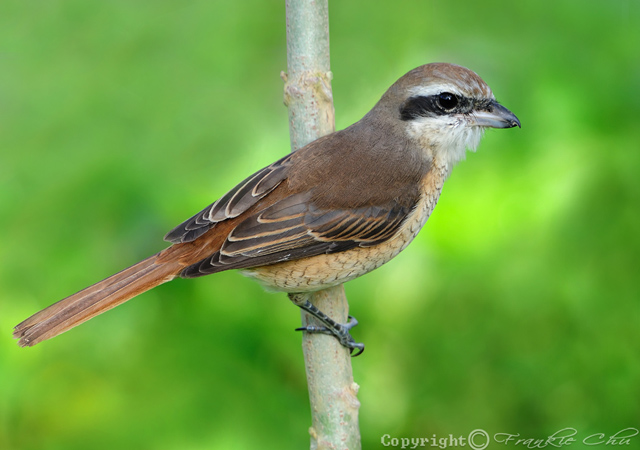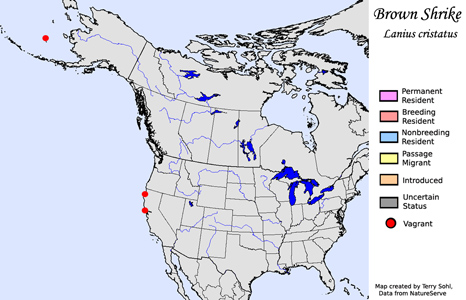| Length: 7.5 inches | Wingspan: 9.5 inches | Seasonality: Non-resident in South Dakota |
| ID Keys: Brownish upperparts, light face with dark eye stripe, long tail. Female plumage shows less overall contrast. | ||
 The
Brown Shrike is a species found throughout much of Asia. In North America,
they are very rare vagrants, with a handful of sightings in Alaska (islands
in the Bering Sea), a pair of sightings in California, and one sightings
near Halifax, Nova Scotia. They are similiar in overall structure and
appearance to the North American shrike species, the
Loggerhead Shrike and
Northern Shrike, but the overall
brown coloration easily distinguishes the species.
The
Brown Shrike is a species found throughout much of Asia. In North America,
they are very rare vagrants, with a handful of sightings in Alaska (islands
in the Bering Sea), a pair of sightings in California, and one sightings
near Halifax, Nova Scotia. They are similiar in overall structure and
appearance to the North American shrike species, the
Loggerhead Shrike and
Northern Shrike, but the overall
brown coloration easily distinguishes the species.
Habitat: Found in brushy thickets, forest edges, vegetated riparian areas, and forest clearings.
Diet: Feeds on insects, as well as small vertebrates such as small mammals and birds. They may also sometimes feed on small reptiles.
Behavior: Hunts by observing from a perch, flying out to capture prey when spotted. Like other shrike species, they may "store" their prey by impaling it on a thorn.
Nesting: The female builds a nest of grasses in a tree or bush, or sometimes on the ground. She lays between 3 and 6 eggs, which are incubated for about 15 days. Young leave the next after 15 to 20 days.
Song: Series of high-pitched, whistled warbles and chipping notes.
Migration: Some birds in the southern part of their central and eastern Asian breeding range may be semi-permanent residents. However, most birds are migratory, with different races of the species each wintering in distinct geographic regions of southern and southeast Asia.
Interactive eBird Map: Click to access an interactive eBird map of Brown Shrike sightings
Similar Species: In North America, the color is different, but general structure and appearance is similar to the North American Shrikes, the Loggerhead Shrike, and Northern Shrike.
Conservation Status: Global populations may be in decline, but they are still found over a very wide geographic region and are common in parts of their range. The IUCN lists the Brown Shrike as a species of "Least Concern".
Further Information: 1) AvianWeb - Brown Shrike
2) BirdLife International - Brown Shrike
3) Brown Shrike (Lanius cristatus) Page
Photo Information: Photo taken by Frankie Chu - Photo licensed under Creative Commons Attribution NoDerivs 2.0 Generic License
| Click below for a higher-resolution map |
 |
| South Dakota Status: Non-resident in South Dakota |
Additional Masked Tityra Photos (coming soon!!)
